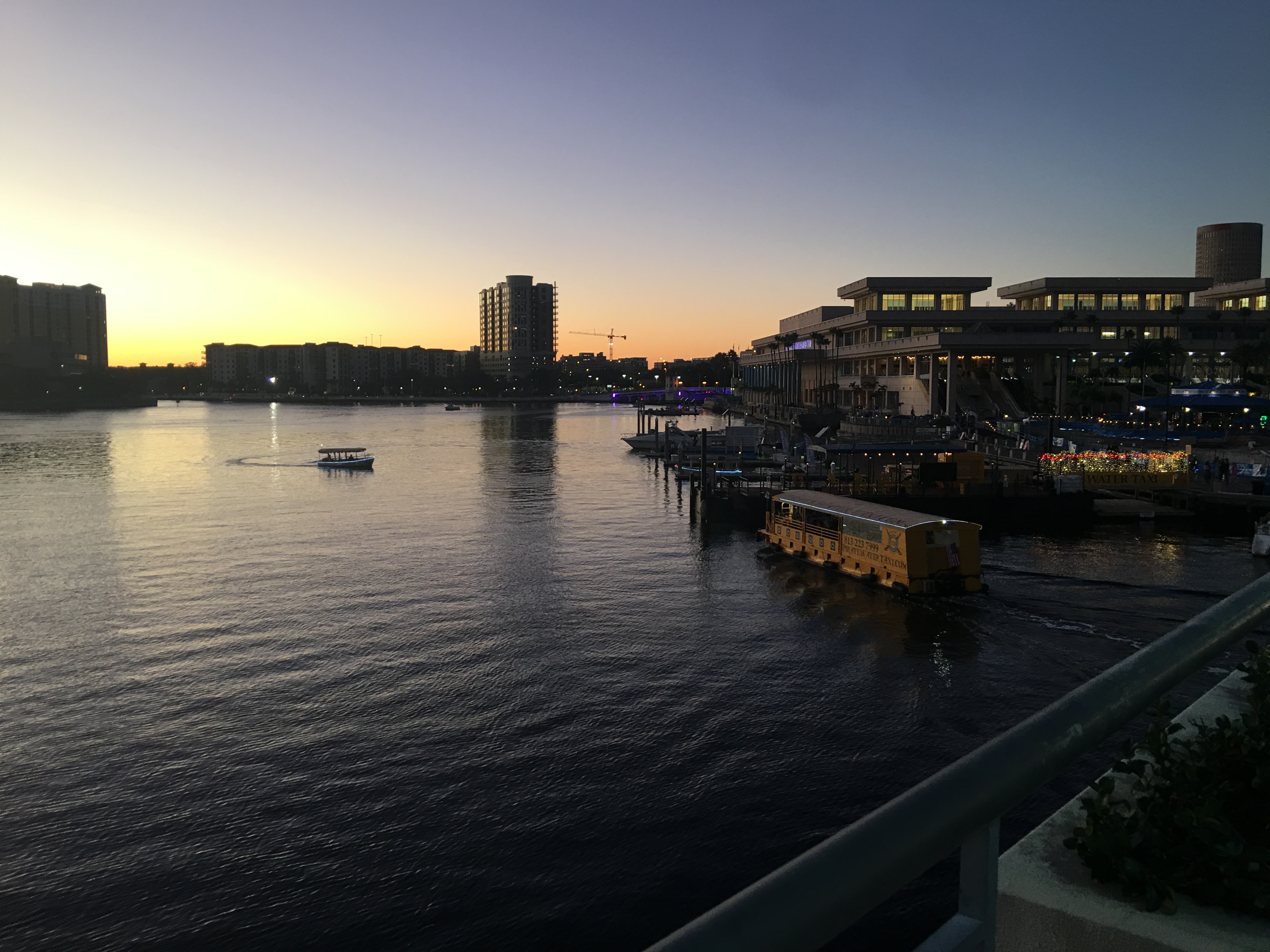The MU Office of Grants, Sponsored Programs, and Research recently organized a feature on some of the work we’re doing in the lab. PatchTown Films did an incredible job filming and producing this video highlighting the amazing work being done by MU students.
Autumn 2023 update
2023 has been a busy and eventful year thus far!
In the lab, we’ve continued work on Gambusia, killifish, snails, and now wood frogs. Each of these projects are focused on how organisms respond to environmental change. Several students and I look forward to presenting the findings of these projects at conferences in the coming months. We’re also gearing up for several research projects that are set to begin in the coming weeks.


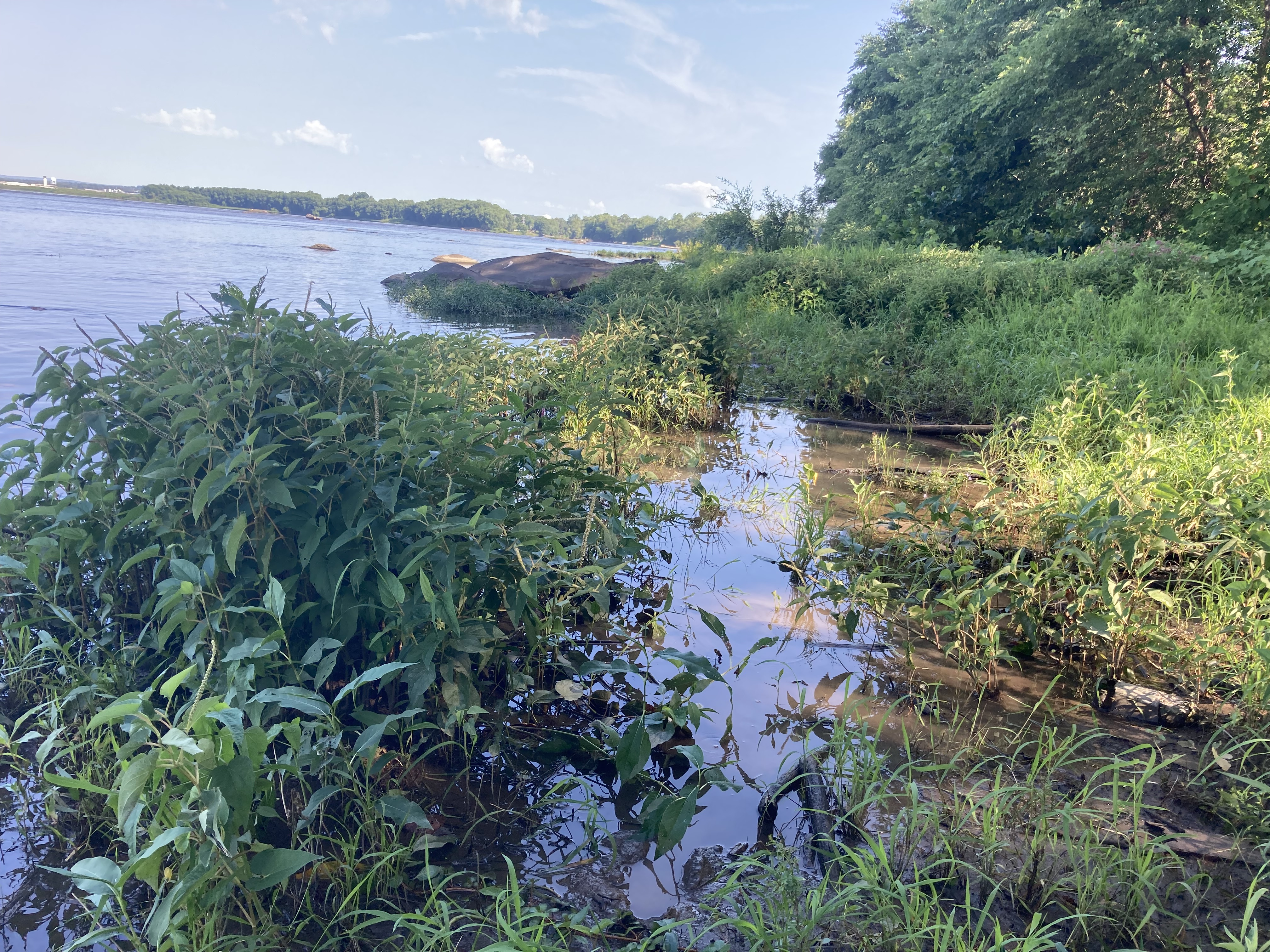
Over the summer I had the opportunity to teach two field courses, one through University of Colorado Boulder (EBIO 4200 – Marine Ecological Research) offered at CARMABI Field Station in Curaçao, and another through Millersville University (BIOL 396 – Ichthyology) offered at Chincoteague Bay Field Station in Virginia.
In Curaçao, I had the opportunity to mentor a group of students on their research project focused on territory defense in Stegastes damselfish. The students managed to collect a lot of interesting data on the relationship between “neighborhood” size and individual participation in defense, and I hope to visit CARMABI again soon to build on their work.




At CBFS, Ichthyology was another great course with a fun group of students. We got to sample a wide range of habitats and learn about many different fish species. One of my favorite parts of the course is the Fishes of the Mid-Atlantic Art Show. Students intently study the morphology of a fish of their choice over the first two weeks of the class as they create their artistic depiction of the fish. They then prepare a presentation on that fish for the show. Students highlight the relationship between morphological features and the fish’s niche, evolutionary history, and behavior. The whole station comes out for this event and enjoys learning about local fish species.
Lab News – Spring 2023
The 2022-23 academic year has been a productive one!
Three Millersville Students presented at the 2023 Society for Integrative and Comparative Biologists meeting in Austin, Texas. Sean Burke (2022) and Nic Walker (2023) presented posters on their long-term study on interactions between native fish and nonnative mosquitofish. Sean’s work focused on morphological changes associated with these interactions and Nic focused on behavioral changes that emerged. Leilani Smith (2022) presented her work on the impacts of herbicide exposure on mosquitofish behavior.

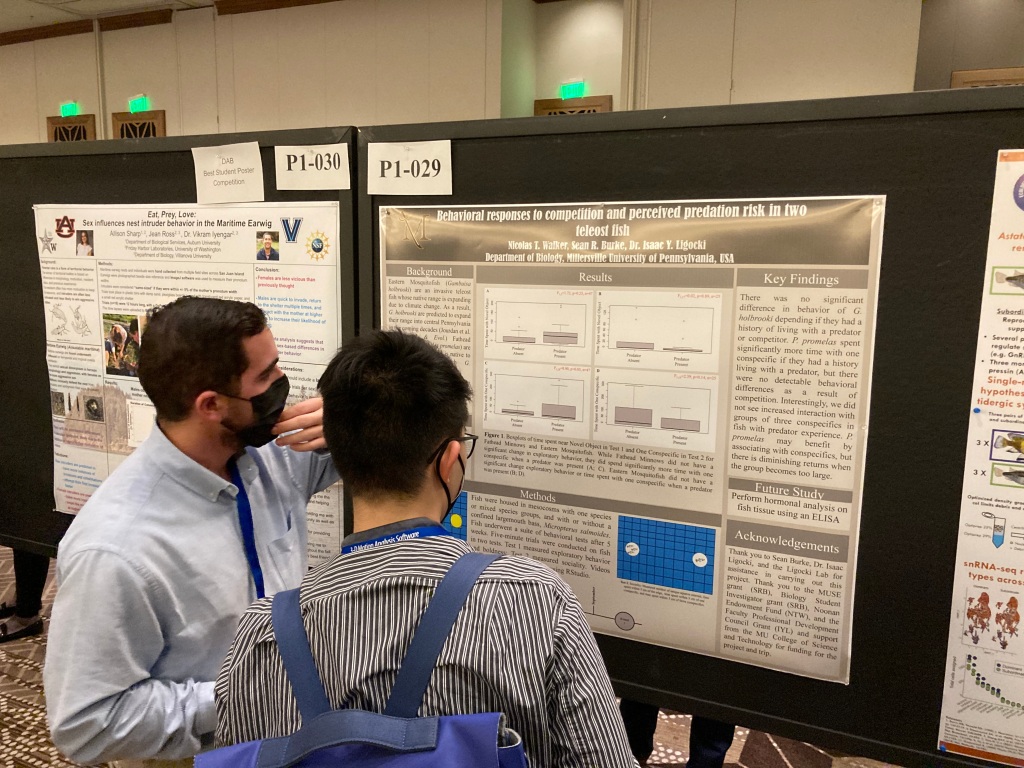



On campus, we’ve begun a few new projects in the lab. One is aimed at understanding social and reproductive behavior in striped killifish (Fundulus majalis) and another is focused on the impacts of ocean acidification on growth and behavior in two species of estuarine snails.


Finally, Sean Burke (2022) has moved to Reno, Nevada where he is now working for the Eastern Sierra Chapter of Trout Unlimited. He is working on habitat restoration in the Truckee River watershed and also engaging in community outreach.

A long overdue Autumn 2022 update
It’s been a busy year!

2022 started at the annual meeting of the Society for Integrative and Comparative Biologists (SICB) in Phoenix, AZ where lab members Leilani Smith and Trinity Young presented their research on social interactions in mosquitofish.



In the spring and into the summer we had several research projects taking place on the effects of pollutants on mosquitofish behavior, as well as how competition and perceived predation risk impact individual fish behavior.




This summer I also got to attend the International Society of Behavioral Ecologists (ISBE) meeting in Stockholm, Sweden where I presented some preliminary findings on multispecies predatory aggregations by teleost fish in Lake Tanganyika. I’ll be presenting updated findings at SICB 2023 in Austin, Texas.
The lab has established an ongoing partnership with the 4th grade classes at Burrowes Elementary School in Lancaster, PA focused on Animal Adaptations, in particular those in fish!

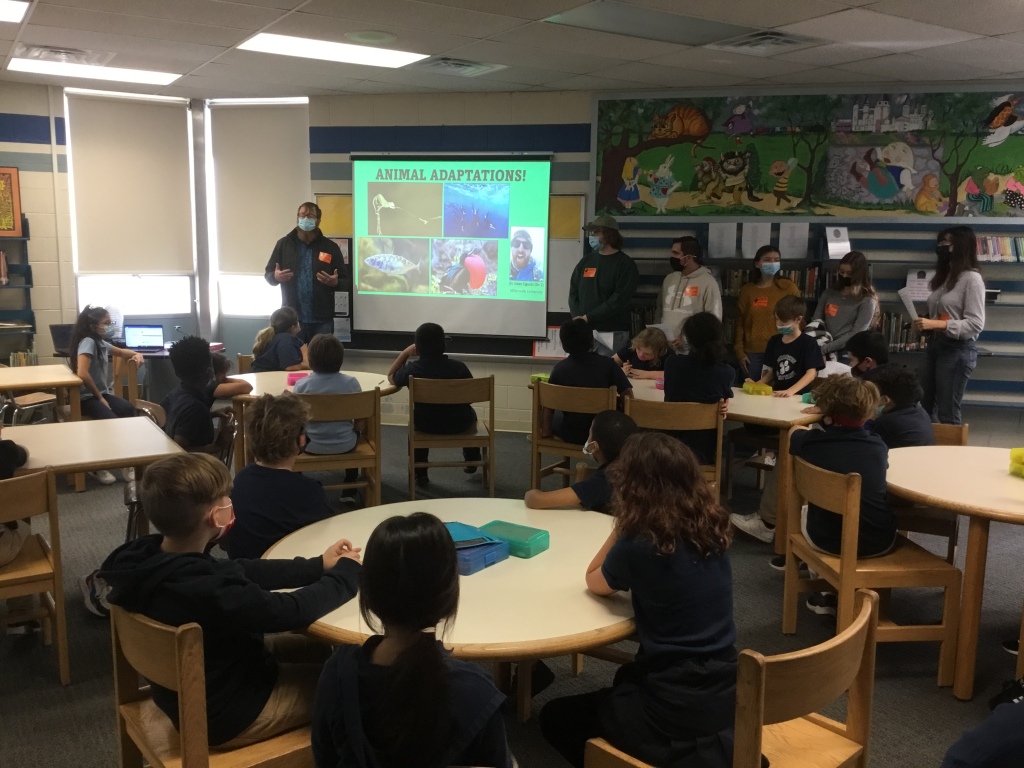
Lab Alumni Updates: Leilani Smith (2022) is currently pursuing a Masters degree at University of Miami (FL). Haley Beck (2021) is an Aquarist at the Maritime Aquarium at Norwalk (CT).
Summer 2021 Update
Despite the pandemic it’s been an exciting and eventful year for the lab!
TEACHING:
While I had to substantially modify my course materials for online instruction, it did provide an opportunity to critically evaluate many of my assignments and approaches to teaching. I’m certainly looking forward to being back in the classroom this fall, but I can say that my courses have been improved as a result of the reflection that online teaching necessitated.
This summer I did have the opportunity to teach two courses at the Chincoteague Bay Field Station in Virginia. It was great to be teaching in person again, and to teach field courses!


STUDENT ACHIEVEMENTS:
Haley Beck (2021) and Leilani Smith (2022) both presented at the Commonwealth of Pennsylvania Biologists (CPUB) meeting held remotely on April 10, 2021. Leilani was awarded 2nd place best student mini-presentation in her session for her presentation.
Haley Beck (2021), Leilani Smith (2022), and Trinity Young (2022) each presented at the Made In Millersville meeting held remotely on April 13th, 2021.
Haley Beck (2021) and Briana Harkins (2021) graduated!

Trinity Young (2022) was awarded a Mentored Undergraduate Summer Experience (MUSE) grant to support the research she has carried out this summer on social network structure in a captive population of African Painted Dogs, Lycaon pictus in collaboration with The Wilds in Cumberland, OH.

Leilani Smith (2022) was awarded a Student Grant for Research and Creative Activity (SGRCA) to support her honors thesis project focused on how endocrine disrupting pollutants influence social behavior in eastern mosquitofish, Gambusia holbrooki.
OTHER EXCITING RESEARCH NEWS:
I was awarded a Faculty Professional Development Council (FDPC) award by PASSHE to support future student-led research on the impacts of endocrine-disrupting pollutants on social, reproductive, and antipredator behavior.
I was awarded the Robertson Junior Faculty Instructorship Award from Millersville University which will provide me release time from teaching during spring semester 2022 to focus on research activities taking place in the lab.
Several manuscripts associated with ongoing projects have been submitted for peer-review. Culbert et al. (2021) was accepted for publication in the journal Hormones and Behavior.
First Half of the First Semester – the in-person half…
Since returning from Zambia, I jumped right into my first semester as an Assistant Professor at Millersville University. The very short summary is I love it, and I’ve never been so exhausted in my life.
I was fortunate in that in Fall 2019 prior to heading to Zambia I had time on campus to get oriented and start planning classes. I was also fortunate to have previously taught courses similar to those I’m teaching now – so I could revise and improve on materials I’d previously developed. Despite these advantages, it’s still been an extremely busy spring…

What’s gone well:
Students are responsive, and their feedback has clearly enhanced classes. I’ve had students fill out surveys several times throughout their semester – the students have been very responsive, and I’ve been able to make positive changes to both of my lecture courses in response.
Students seem to be enjoying the classes. In addition to constructive feedback in the surveys, the general consensus seems to be the students are enjoying the courses I teach. I’ve been able to modify the curriculum to address relevant current topics including the emergence of COVID-19 and Ethics in Science.
Undergraduate Research. I currently have two awesome teams of undergraduates working on research projects. One team of four have worked together to develop a project on social network establishment in Poeciliid fishes, another team of five students is analyzing 100+ hours of behavioral videos I collected from Lake Tanganyika. Watch out for some cool stuff out of these teams!
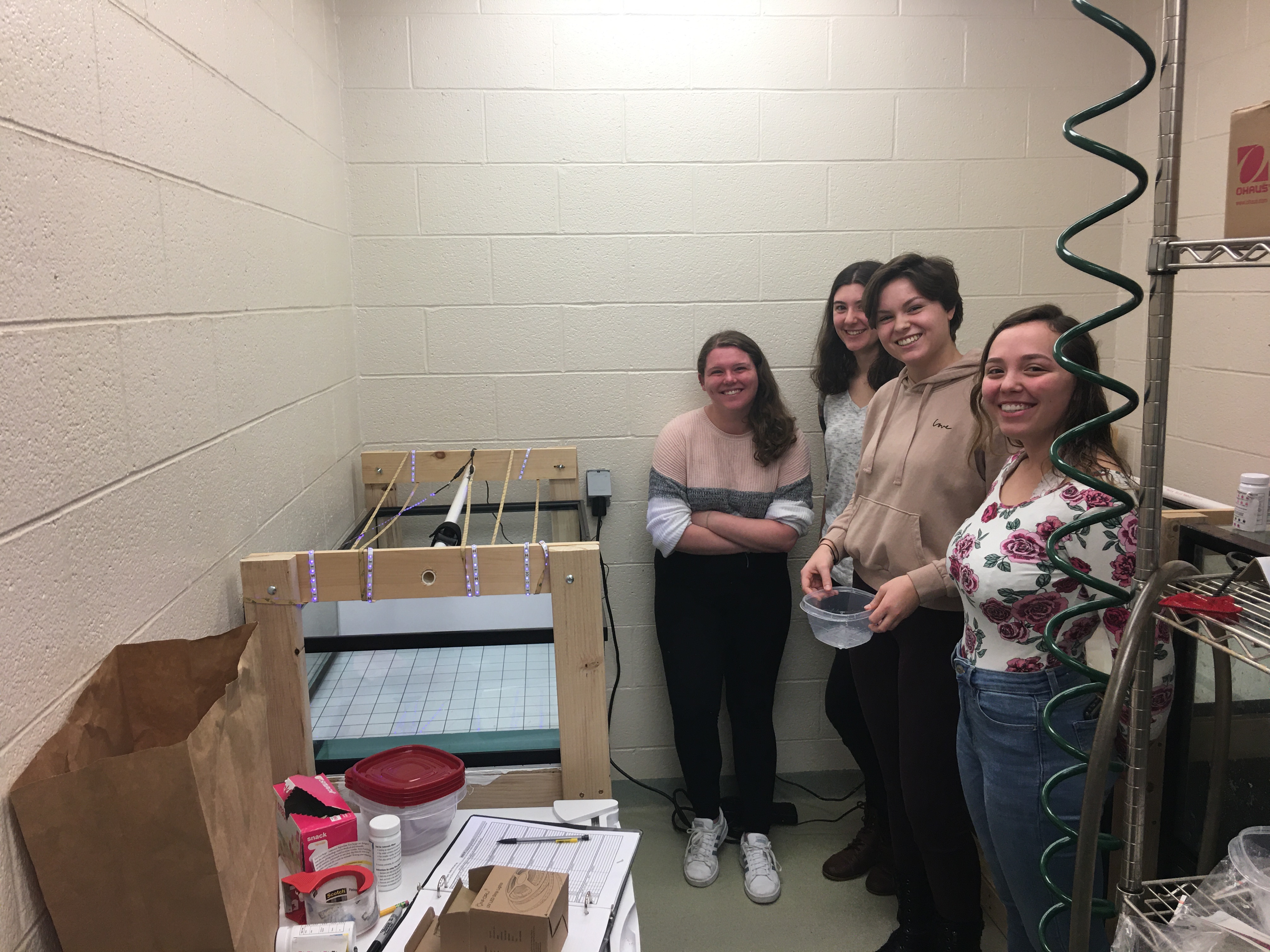
Teaching Elementary School Students about the Social Lives of Animals. I was invited to give a talk at Infinity Charter School in Harrisburg, PA. The students were a blast, and they sent me some really sweet thank you letters.

What I’m looking forward to improving on:
Modifying Animal Behavior labs so that students can make reasonable predictions about how the animals should behave. The labs are cool, but fiddler crabs have made my life difficult more than once this semester…

Getting Involved in Collaborative Projects with my colleagues. We have a great team in the Department of Biology here at Millersville, and I’m looking forward to working with them to further enhance our curriculum, our outreach to the community, and to develop more undergraduate research opportunities for students.
Staying caught up on grading.
Establishing more connections in the area and state to better facilitate student learning.

Like nearly everywhere else, Millersville University is shifting online for the remainder of the semester due to COVID-19. As frustrating and stressful as the transition to online teaching is, its presented a great opportunity to take a critical look at our content and whether and how it connects to the aims of the course.
It’s my hope we’re back on campus this summer and fall, that we’re past the main threat of the virus, and that we continue to make big things happen!
Lake Tanganyika Expedition 2019
After well over a year of planning and organizing, I spent the last two months of 2019 on a research expedition to the Zambian shore of Lake Tanganyika. This expedition was a collaboration between Ohio State University, McMaster University, University of Wollongong, University of Zambia, and the Zambian Department of Fisheries. On this trip, we investigated the behavior and physiology of a group of very unique fish there.

Several species of fish in this lake have evolved to live in complex social groups often referred to as Cooperatively Breeding Societies. In general, these societies are characterized by groups of individuals living together in groups in which not all group members reproduce, and non-reproductive group members help raise the offspring of other group members. Such societies are common in mammals and birds, but they’re extremely rare in fish. In fact, the only fish known to live in such groups are a small group of closely related cichlid fish living in one place – Lake Tanganyika. The general aim of our expedition was to study these social groups, to better understand how these social systems evolved, and to understand how the physiology of these fish relates to their unique social behavior.
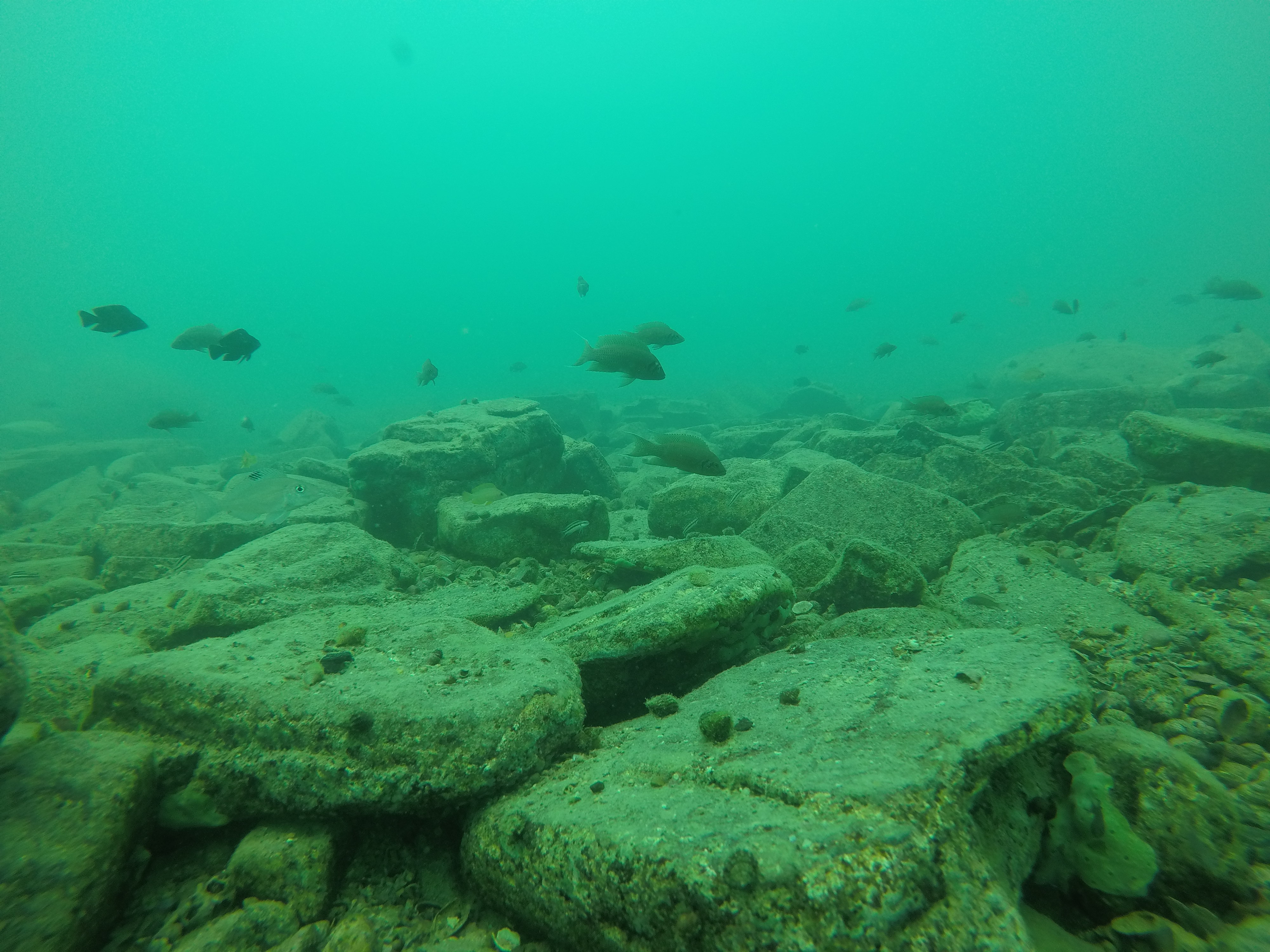
We performed a number of experiments during the expedition; in the coming months we look forward to presenting our findings and I look forward to sharing them here. In this post however, I’ll highlight some of my takeaways from the trip.
Science is Collaborative. In addition to our expedition team, this trip would not have happened without the guidance and assistance of a number of other scientists. Without help from research teams at Osaka City University, University of Bern, Max Planck Institute, and University of California, Davis, we would not have been able to do our work. Since establishing relationships with these scientists, additional collaborations (and friendships) have been established.
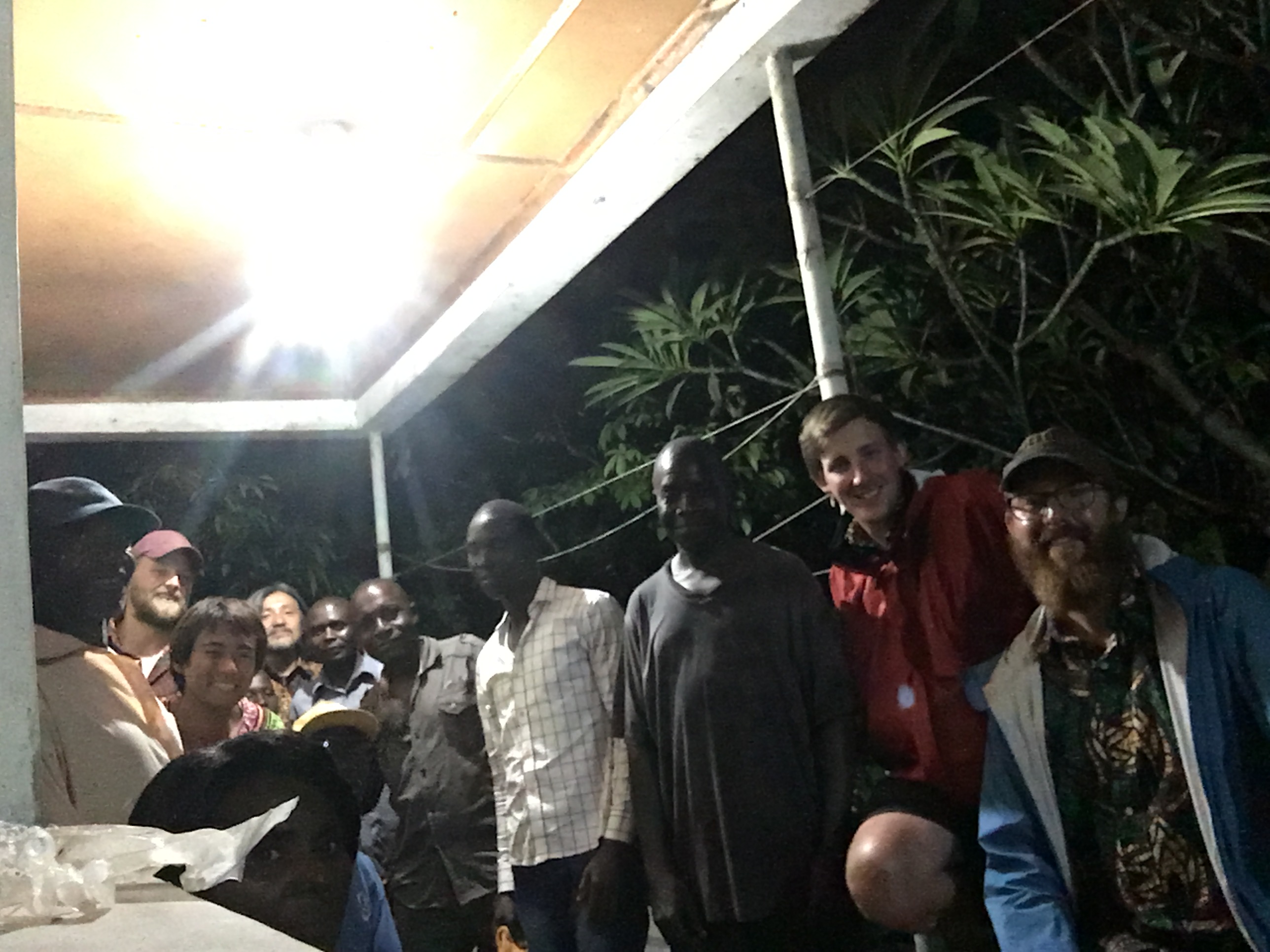
Every scientist has experienced or heard stories of scientists not working well together. Whether being secretive and distrusting, or outright obstructing others, such interactions harm scientific progress. This expedition was an encouraging example of how scientists at different institutions can work together to everyone’s benefit.
Experiments Don’t Always Work. Things go wrong in science, especially in the field. Whether it’s bad weather, broken equipment, or simply the fact that some fish would just rather swim away than be observed, experiments rarely go exactly as planned. This is an example of how science is a creative process. Scientists need to be able to think creatively about how to solve problems and design experiments that will allow them to answer interesting and important questions.
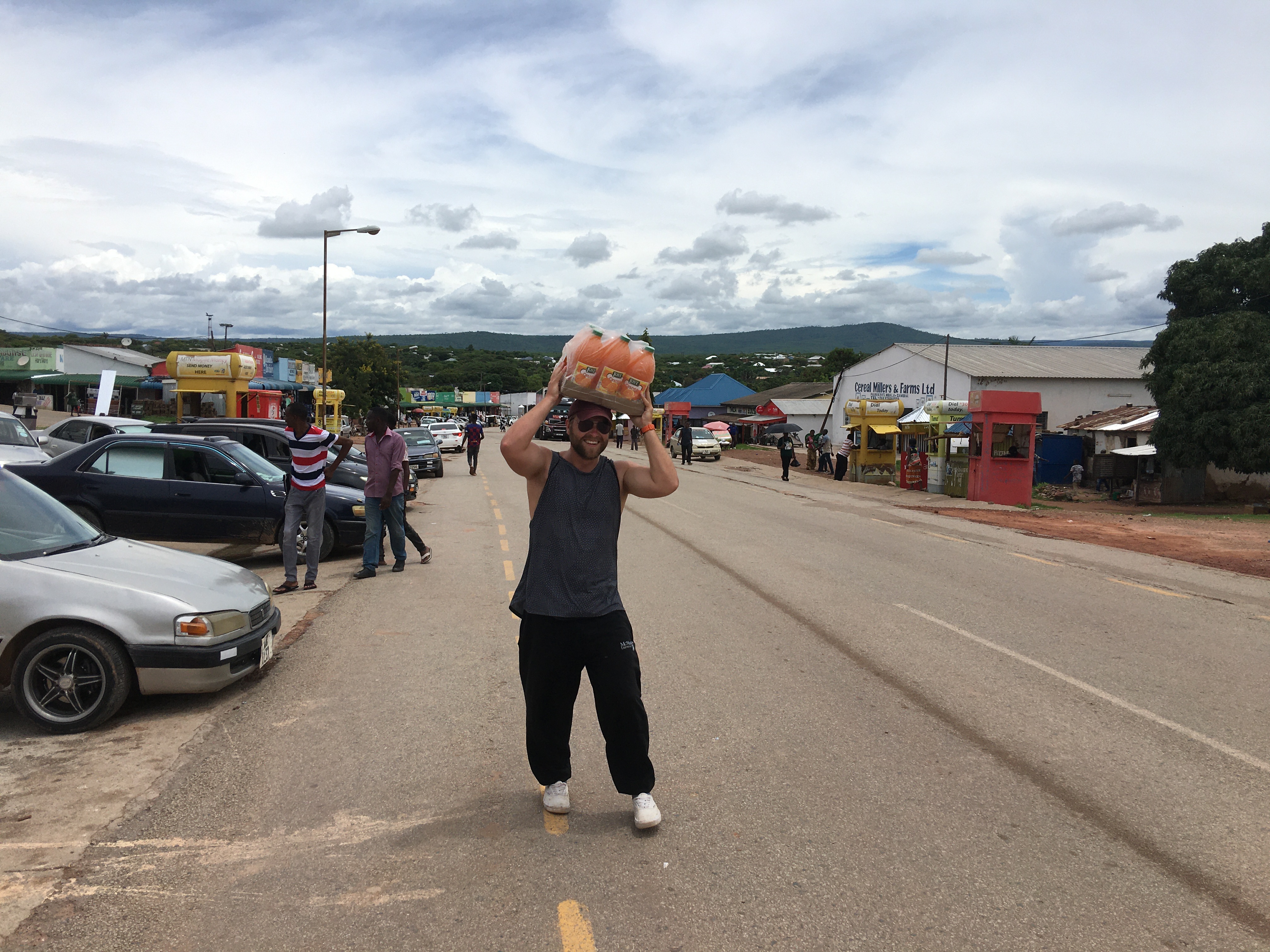
As was expected, we dealt with many setbacks along the way. But in general we were able to overcome each of them by working together and thinking creatively.
Enjoy the Experience. Opportunities like this expedition are rare. One evening while discussing the trip, we reflected on the fact that we are amongst a relatively small number of people who have dove in Lake Tanganyika. Getting there is hard enough that very few outsiders go, but to dive when you’re there is very special.

Lake Tanganyika is changing fast. Cities and villages along its shores are growing quickly, and advances in infrastructure will further facilitate future growth. In many ways this is great news for the people living near the lake; but overfishing, pollution, and urban runoff were even more apparent than when I last visited the lake in 2013. I hope the people of Zambia and the other countries bordering the lake are able to preserve the lake and its valuable resources for future generations. Lake Tanganyika is truly a special place, and not only because of its unique fish.

I’m excited to be home and to start my new position at Millersville University in a few weeks, but I hope I get the opportunity to return to Lake Tanganyika soon!
Scientific Diver Certification

In preparation for field work this fall I had the opportunity to become an AAUS certified scientific diver through UC Davis’ Bodega Marine Lab. The course involved three weekends and a final week on classroom activities, first aid training, pool exercises, and diving the Sonoma Coast.
The course was an outstanding experience. Not only did I learn a lot, I had a great time doing it. Unquestionably what I learned will be valuable for field work in Zambia this fall, and down the road as well.
Much of the scientific part of the course revolved around maritime archaeology from when the Sonoma Coast was being explored in the late 19th century. Many of our dives revolved around searching for and documenting artifacts in coves and bays that served as “doghole ports” where ships would enter and cargo would be loaded via chutes from the cliffs above. We found several previously undocumented anchors, as well as a number of other artifacts. While well outside my research expertise, I could certainly see marine archaeology becoming a hobby down the road!

Behavioral Ecology Night Hike!

This week I had the chance to bring my Behavioral Ecology students out to Putah Creek Riparian Reserve for a night hike to have some firsthand exposure to the nocturnal behavior of animals native to the Central Valley of California.

Our activity revolved around three key activities 1) chorus frog calls and courtship, 2) owl communication, and 3) how to study animals that are hard to actually observe. I was fortunate to recruit a group of amazing biologists eager to talk about these topics with my students, and fortunately the animals cooperated (even if my camera didn’t).
Thanks to Rob Blenk, Amelia Munson, Marcus Michelangeli, Justin Clause, and Heather Ligocki for sharing their expertise, helping out with the activity, and ensuring it went smoothly! Additionally, thanks to UC Davis Department of Wildlife, Fish, and Conservation Biology, as well as the UC Davis Arboretum for logistical support and approval for this activity. The students loved it!
SICB 2019
SICB 2019 wrapped up on Monday, and it was a great conference as usual!

This year three students I taught and mentored in a Field Marine Ecology course presented their research on joint territory defense in Dusky Damselfish (Stegastes adustus). They performed this work in Quintana Roo, Mexico, and they did a phenomenal job presenting the results of their study. SICB was a great first major conference for them, as they not only had the opportunity to discuss their work with veteran researchers who’d studied damselfish their entire career, but also hear about a wide range of interesting research topics they’d never been exposed to.
I spoke on an aspect of my postdoctoral work that was recently accepted in Aquatic Toxicology – through this study we identified changes in gene expression associated with exposure to a widely used pesticide (bifenthrin) in the western mosquitofish (Gambusia affinis). In spite of transcriptional changes in genes associated with reproduction and the stress response, we did not identify behavioral shifts as a result of exposure.
In addition to excellent presentations and great conversations with other scientists, Tampa was a great host city!
